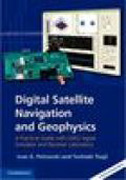
Digital satellite navigation and geophysics: a practical guide with gnss signal simulator and receiver laboratory
Petrovski, Ivan G.
Tsujii, Toshiaki
Langley, Richard B.
Your hands-on guide to GNSS theory and applications, with practical case studies and bundled real-time software receiver and signal simulator. Link your theoretical education to practical work experience with this hands-on guide toGNSS receiver technology, which includes numerous real-world examples, case studies and exercises. Also provided is a real-time software receiver and signal simulator, enabling you to create your own GNSS lab for research or study. Link your theoretical education to practical work experience with this hands-onguide to GNSS receiver technology, which includes numerous real-world examples, case studies and exercises. Also provided is a real-time software receiver and signal simulator, enabling you to create your own GNSS lab for research orstudy. Bridge the gap between theoretical education and practical work experience with this hands-on guide to GNSS, which features: â€ó A clear, practical presentation of GNSS theory, with emphasis on GPS and GLONASS â€ó All the essential theory behind software receivers and signal simulators â€ó Key applications in navigation and geophysics, including INS aiding, scintillation monitoring, earthquake studies and more â€ó Physical explanations of various important phenomena, including the similarity of code delay and phase advance of GNSS signals, and negative cross-correlation between scintillation intensity and phase variations. Whether you are a practising engineer, a researcher or a student, you will gain a wealth of insights from the authors' 25 years of experience. You can explore numerous practical examples and case studies and get hands-on user experience with a bundled real-time software receiver, signal simulator and a set of signal data, enabling you to create your own GNSS lab for research or study. Advance praise: 'This book provides an excellent introduction tosatellite navigation and the technologies that make it possible. The authors set forth both fundamentals and practical aspects in a manner that allows evennewcomers to GNSS to utilize it effectively. The topics covered in this book address the most important elements of current-day GNSS applications.' Sam Pullen, Stanford University INDICE: Foreword Richard B. Langley; 1. Methods of positioning with navigation satellites; 2. Presentations and applications of GNSS orbits; 3. GNSS signal generation in transmitters and simulators; 4. Signal propagation through the atmosphere; 5. Receiver RF front end; 6. Real-time baseband processor on a PC; 7. Multipath; 8. Optimization of GNSS observables; 9. Using observables innavigation related tasks; 10. Electromagnetic scintillation of GNSS signal; 11. Geophysical measurements using GNSS signals; 12. INS aiding in baseband andnavigation processors.
- ISBN: 978-0-521-76054-6
- Editorial: Cambridge University
- Encuadernacion: Cartoné
- Páginas: 338
- Fecha Publicación: 29/03/2012
- Nº Volúmenes: 1
- Idioma: Inglés
